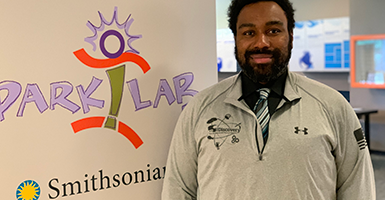March 17, 2022 / News & Blog

| This article is part of the “Children’s Museums and Climate Change” issue of Hand to Hand. Click here to read other articles in the issue. |
By Chris White, The Discovery
When I first moved out to Nevada from Maryland to join The Discovery team, one of the first phrases I had to get used to was “fire season,” the time of year when fires naturally occur in the drier parts of Nevada and other western states. Over the past few years, these fires have become more common, more intense, and more devastating.
Fire season is evolving faster than normal, and it’s drier now. We either get no rain or dumped on. Sometimes if there is no rain at all in the fall, we have to wait for winter snowfall to provide moisture. Fire season used to run for about three months, starting at the end of August; now it runs five to six months, starting end of June and going late into fall. The cycle is out of whack.
Fires happen often in remote mountain areas. Some are due to natural causes, such as lightning strikes, but some result from human activities, such as shooting, campfires, and cigarettes. In 2021, the Portola, California, fire burned just fifty miles away. Reno sits in a bowl—once smoke comes, it settles in for weeks. We can wait for a “Washoe wind” (a strong, late-day summer wind that blows from the west to southwest) to blow it away, or just sit tight until it dissipates. But in 2021, school was cancelled due to poor air quality, and people were warned to stay indoors and keep windows shut. Not everyone has air conditioning; it became a social issue.
Fire season isn’t all bad. It is a crucial part of the region’s ecosystem. The West wouldn’t be as beautiful or environmentally diverse without these fires. However, the fires are getting bigger and more destructive. According to the Center for Disaster Philanthropy, over the past two years, California and Nevada have lost more than 6,000 square miles of land. For comparison, that is 80 percent of New Jersey’s landmass. As a science museum, our responsibility is to provide useful information about this climate-related change to our community while engaging and empowering them with that knowledge.
To that end, we have developed a three-part plan to help us create a vibrant and dynamic collaborative space within our existing Spark!Lab Smithsonian gallery, in which half of the gallery’s footprint will be dedicated to teaching families about fire season while still engaging them through play. Visitors will be able to meet community members to whom fire season matters most—instructors and graduate students from the University of Nevada, Reno, local firefighters (if they aren’t fighting fires…), and members of the Bureau of Land Management—and learn how they respond to this increasingly longer time of year.
We are also working with these key community members to create easy-to-understand infographics that visually convey what happened in past fire seasons compared to what is happening now. Infographics that not only describe what is happening, but why will be placed throughout Spark!Lab and in some parts of our Nevada Stories exhibition. For our family audience, messages will be directed primarily to parents in an effort to get them involved in the education process with their kids
The second part of the plan involves the creation of interactive, collaborative activities in which visitors work together to solve fire-related problems. The first will be a firefighting game where up to three visitors will assume the roles of community leaders tasked with managing assets affected by fire season. By pulling connected strings, they can work toward extinguishing as many fires as possible in the time allotted. Also under development is a tile-based, firefighting board game, similar to Catan (a popular electronic seafaring discovery game). In our game, one player is the wildfire, and the other player(s) try to contain the spread while each tries to fulfill roles within the community.
The final pillar of the plan will bring community leaders and stakeholders most involved in protecting our community during fire season to the museum for a “meet and greet.” We want our visitors to put a face to the heroes in our community who choose to take on this yeoman’s work. Visitors will hear firsthand the issues affecting our hometown and what these frontline experts think we can do to mitigate and manage what is happening.
It is hoped that fire season content, launched in Spark!Lab and periodically distributed among existing exhibits at The Discovery, may eventually become a portable exhibit available for outreach events or temporary installations in other community organizations and businesses.
Fire season is an integral part of what makes the West special. But for many reasons, the fires have begun to take more than they previously provided and more than we can replace. It falls to us to educate ourselves and our community if we hope to pass the beauty of living in this spectacular environment on to future generations.
Chris White is The Discovery’s Spark!Lab Smithsonian Coordinator. Prior to joining the team at The Discovery, Chris worked at the original Spark!Lab in Washington, DC, which is part of the Lemelson Center for the Study of Invention and Innovation located in the Smithsonian National Museum of American History.